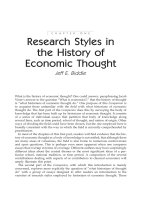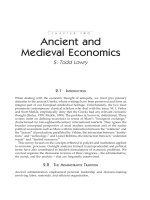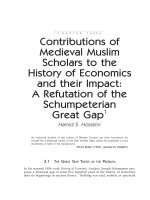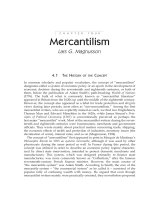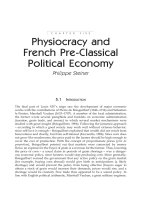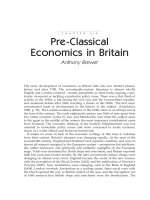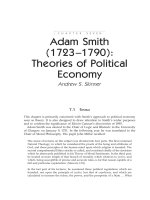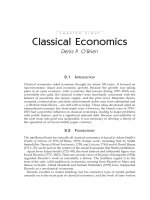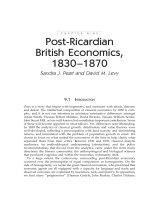An Outline of the history of economic thought - Introduction pps
Bạn đang xem bản rút gọn của tài liệu. Xem và tải ngay bản đầy đủ của tài liệu tại đây (310.95 KB, 34 trang )
AN OUTLINE OF THE HISTORY OF
ECONOMIC THOUGHT
This page intentionally left blank
An Outline of the
History of Economic
Thought
Second Edition Revised
and Expanded
ERNESTO SCREPANTI
and
STEFANO ZAMAGNI
Translated by David Field and Lynn Kirby
AC
AC
Great Clarendon Street, Oxford OX2 6DP
Oxford University Press is a department of the University of Oxford.
It furthers the University’s objective of excellence in research, scholarship,
and education by publishing worldwide in
Oxford New York
Auckland Cape Town Dar es Salaam Hong Kong Karachi
Kuala Lumpur Madrid Melbourne Mexico City Nairobi
New Delhi Shanghai Taipei Toronto
With offices in
Argentina Austria Brazil Chile Czech Republic France Greece
Guatemala Hungary Italy Japan Poland Portugal Singapore
South Korea Switzerland Thailand Turkey Ukraine Vietnam
Oxford is a register ed trade mark of Oxford University Press
in the UK and in certain other countr ies
Published in the United States
by Oxford University Press Inc., New York
# Ernesto Screpanti and Stefano Zamagni, 2005
The moral rights of the authors have been asserted
Database right Oxford University Press (maker)
First published 2005
All rights reserved. No part of this publication may be reproduced,
stored in a retrieval system, or transmitted, in any form or by any means,
without the prior permission in writing of Oxford University Press,
or as expressly permitted by law, or under terms agreed with the appropriate
reprographics rights organization. Enquiries concerning reproduction
outside the scope of the above should be sent to the Rights Department,
Oxford University Press, at the address above
You must not circulate this book in any other binding or cover
and you must impose the same condition on any acquirer
British Library Cataloguing in Publication Data
Data available
Library of Congress Cataloging in Publication Data
Data available
Typeset by Newgen Imaging Systems (P) Ltd., Chennai, India
Printed in Great Britain
on acid-free paper by
Biddles Ltd., King’s Lynn, Norfolk
ISBN 0–19–927913–6 (Hbk) 978–0–19–927913–5
ISBN 0–19–927914–4 (Pbk) 978–0–19–927914–2
13579108642
PREFACE TO THE SECOND ENGLISH
EDITION
Our satisfaction in writing the second English edition of this book is easy to
imagine: not only are we assured of the utility of our work, but also have the
opportunity to enlarge and revise it. We have attempted to do this in various
ways. We have removed oversights and errors; we have made a few additions
and expanded a little on all chapters; we have re-written and simplified
various parts which students had found obscure or difficult to understand;
lastly, we have updated the bibliography, with the aim of offering useful
suggestions for further reading.
More substantial integrations have been made to chapters 1, 2, 4, 9 and 11.
In the first chapter we felt it necessary to recall the role played by humanism
and the Renaissance in the birth of political economy and, in particular, the
contribution they made to the formation of ‘civil humanism’, a philosophical
approach that fell into disuse following the advent of utilitarianism, but now
appears set for a second revival. In the chapter on Smith we have integrated
our exposition of the interpretations of his thought by recalling the one that
is today considered the most convincing, that of Smith as an institutionalist
economist. The chapter on Marx has also been enlarged to recall his con cept
of man and his investigation into the social and institutional conditions of
capitalist production, two of the most topical parts of his thinking. Lastly,
in ch apter 9, we have separated treatment of the post-Keynesian approach
from the so-called ‘new Keynesian macroeconomics’, by further expanding
on both and pointing out the important differences that distinguish the two
schools. We have also adde d a summary paragraph with a simple diagram
comparing the views of the various contemporary schools of macroeconomics.
In chapter 11 we have added extensive paragraphs on evolutionary games and
the theories of growth and complexity.
In addition, we have introduced a new chapter—the twelfth—which
deals with the current situation of economic science. The state of crisis
which has beset our discipline over the last thirty years appears even more
evident today than when we wrote the first edition of this book. Now we
believe it to be a healthy crisis and in chapter 12 we have endeavoured to
explain why. A crisis can also be a revolution. We do not pretend to know
what will happen in economic science over the next twenty years or so, but
it seemed important to us to clarify the reason why, in our opinion, we are
in the middle of a crisis of foundations that may make history begin again
from Adam.
Finally, a formal change has been made which we hope will be useful for
students. We have removed many references to relevant works from the main
text and entered them in special bibliographic lists at the end of each chapter.
Only those refer ences to fundamental works, which no student can afford to
overlook, have been left in the text.
Let us conclude by thanking friends and colleagues who have taken it
upon themselves to read and comment on the integrations to this edition:
Elettra Agliardi, Luigino Bruni, Luca Fiorito, Nicholas Theocarakis, Carlo
Zappia, and Luca Zarri.
vi
preface to the second english edition
PREFACE TO THE FIRST EDITION
Our experience in the teaching of economics and its history has made one
thing plain to us: that keeping the two subjects separat e, if it was ever jus-
tified, is certainly not today. In the face of the crisis of the theoretical
orthodoxies of the 1950s and 1960s, the flowering of innovations in recent
years, and the numerous rediscoveries of traditional wisdoms, it is no longer
an easy task to teach economic principles. We feel it necessary, therefore, to
teach economic theory by paying careful attention to its history. We have
tried to satisfy this need in our book, and this already says a great deal about
the way it has been conceived. We have endeavoured to present traditional
theories as living matt er, as well as presenting modern theories as part of a
historical process and not as established truths.
On the one hand, we have tried to resist the double temptation of
rereading the past only in the light of the present and explaining the present
only by the past, or, to be more precise, to avoid searching in the traditional
theories for the seeds of the modern theories and explaining the latter as
simple accumulations of knowledge. On the other hand, we ha ve attempted
to distance ourselves from the implicit banality of the great historiographical
alternatives, such as ‘internal’ and ‘external’ history or ‘continuism’ and
‘catastrophism’. We have also tried to avoid the dichotomy which still exists
today, and which seems to us to cause misleading simplifications, between
the ‘pure’ historians of thought, who dedicate themselves exclusively to
studying ‘facts’, and the ‘pure’ theorists, who are only interested in the
evolution of the logical structure of theories. We believe that knowledge of
the ‘environment’ in which a theory is formed is just as important as
knowledge of its logical structure, and we do not accept the view that an
analysis of the emergence of a theory must be considered as an alternative to
the study of its internal structure. This historical outline is, therefore, neither
a collection of discoveries nor a portrait gallery.
Our choice to give a fair amount of historical weight to modern devel-
opments has entailed the problem of where to end our narrative. This cannot
but be a subjective decision. We have chosen the 1970s, but we have reserved
the right to break this rule each time we felt it necessary—for example, in the
case of research work and debates which produced important results in the
1980s but which began earlier. The only precaution we have taken in these
cases has been to avoid citing names and titles, with a few exceptions, and
limiting ourselves to outlining the essential elements of the most recent
theoretical developments.
The reader accustomed to traditional history books may be surprised by
the large amount of space we have reserved for the thought of the last fifty
years—approximately half the extent of a book that still remains (all things
considered) fairly concise. If there is an imbalance of this type, however, we
believe it is that we have dedicated too little space to modern theories.
Quantitative historiographical research has shown, whichever index is used,
that scientific production has grown at an exponential rate in the last
five centuries, with the remarkable consequence that certainly more than
70 per cent of the scientists who have ever lived are living today, and perhaps
a great many more. The decision to devote less than 70 per cent of our book
to modern theory was, in fact, prudent.
Finally, we have no wish to avoid certain difficulti es, or, rather,
responsibilities, connected with our endeavour to treat the present as
history. We are well aware of the danger of the attempt to be wise in the
sense advocated by William James, who believed that the art lays in knowing
what to leave out. We realize that this danger becomes greater the smaller
the distance from the material dealt with and the larger the quantity of
material about which decisions must be made; but we believe that these
responsibilities must be faced. We do not know whether we have been wise in
this sense, or to what degree, but we are convinced of one thing: even if we
have omitted many things from this book, the resulting selection has been
justified, in fact necessitated, by the importance of the material upon which
we focus.
This book is not directed to a specialist public, nor solel y to a student
audience. We also hope to reach the educated person, or, rather, the person
who wishes to educate herself or himself. Specialist training is not, therefore,
necessary to understand this book; a basic knowledge of economics, how-
ever, especially the main themes of micro- and macroeconomics, would be of
help. This is true for most of the book. There are, however, sections, espe-
cially those dealing with the modern theories, in which the analytical diffi-
culties cann ot be avoided without falling into the trap of oversimplification.
In these cases, which we have tried to keep to a minimum, we have chosen to
avoid banality and to ask the reader for a little more effort.
This knowledge of the audience to whom the book is directed may help in
understanding several things about its structure; we have chosen, for
example, to avoid weighing down the narrative with footnotes, a choice that
has often restricted us, but which we hope will benefit the reader. On the
other hand the bibliographies presented at the end of each chapter do not
pretend to be complete; they con tain, apart from details of works quoted
from, only a short guide to further reading.
Finally, we should like to express our gratitude to the many colleagues and
friends who have kindly and generously agreed to read and comment on the
first drafts of our book, or on parts of it. In particular we would like to
mention Duccio Cavalieri, Marco Dardi, Franco Donzelli, Riccardo Faucci,
Giorgio Gattei, Augusto Graziani, Peter Groenewegen, Vinicio Guidi, Geoff
Hodgson, Alan Kirman, Jan Kregel, Marcello Messori, Pierluigi Nuti,
Fabio Petri, Pier Luigi Porta, Maurizio Pugno, Piero Tani, and Warren
viii
preface to the first edition
Young. Of course any inadequacies or mistakes in this book are our own sole
responsibility. Our thanks also go to Andrew Schuller and Anna Zaranko of
Oxford University Press for their perceptive e ditorial work and advice.
E. S.
S. Z.
ix
preface to the first edition
This page intentionally left blank
CONTENTS
Preface to the second edition v
Preface to the first edition vii
Introduction 1
PART I FROM THE ORIGINS TO KEYNES
1. The Birth of Political Economy 19
1.1. Opening of the Modern World 19
1.1.1. The end of the Middle Ages and scholasticism 19
1.1.2. Communes, humanism and the Renaissance 22
1.1.3. The expansion of ‘Mercantile’ capitalism 27
1.1.4. The Scientific Revolution and the birth of political
economy
29
1.2. Mercantilism 32
1.2.1. Bullionism 32
1.2.2. Mercantilist commercial theories and policies 34
1.2.3. Demographic theories and policies 36
1.2.4. Monetary theories and policies 38
1.2.5. Hume’s criticism 40
1.2.6. Theories of value 41
1.3. Some Forerunners of Classical Political Economy 43
1.3.1. The premisses of a theoretical revolution 43
1.3.2. William Petty and ‘political arithmetick’ 45
1.3.3. Locke, North, and Mandeville 47
1.3.4. Boisguillebert and Cantillon 49
Relevant Works 51
Bibliography 52
2. The Laissez-Faire Revolution and Smithian Economics 54
2.1. The Laissez-Faire Revolution 54
2.1.1. The preconditions of the Industrial Revolution 54
2.1.2. Quesnay and the physiocrats 55
2.1.3. Galiani and the Italians 58
2.1.4. Hume and Steuart 63
2.2. Adam Smith 65
2.2.1. The ‘mechanical clock’ and the ‘invisible hand’ 65
2.2.2. Accumulation and the distribution of income 68
2.2.3. Value 69
2.2.4. Market and competition 72
2.2.5. Smith’s three souls 73
2.2.6. Smith as an institutionalist 77
2.3. The Smithian Orthodoxy 82
2.3.1. An era of optimism 82
2.3.2. Bentham and utilitarianism 83
2.3.3. The Smithian economists and Say 85
Relevant Works 87
Bibliography 88
3. From Ricardo to Mill 90
3.1. Ricardo and Malthus 90
3.1.1. Thirty years of crisis 90
3.1.2. The Corn Laws 91
3.1.3. The theory of rent 92
3.1.4. Profits and wages 95
3.1.5. Profits and over-production 96
3.1.6. Discussions on value 97
3.2. The Disintegration of Classical Political Economy in
the Age of Ricardo
100
3.2.1. The Ricardians, Ricardianism, and the classical tradition 100
3.2.2. The anti-Ricardian reaction 102
3.2.3. Cournot and Dupuit 104
3.2.4. Gossen and von Thu¨nen 107
3.2.5. The Romantics and the German Historical School 109
3.3. The Theories of Economic Harmony and Mill’s Synthesis 111
3.3.1. The ‘Age of Capital’ and the theories of economic harmony 111
3.3.2. John Stuart Mill 113
3.3.3. Wages and the wages fund 115
3.3.4. Capital and the wages fund 118
3.4. English Monetary Theories and Debates in the Age of
Classical Economics
121
3.4.1. The Restriction Act 121
3.4.2. The Bank Charter Act 124
xii
contents
3.4.3. Henry Thornton 127
Relevant Works 130
Bibliography 131
4. Socialist Economic Thought and Marx 133
4.1. From Utopia to Socialism 133
4.1.1. The birth of the workers’ movement 133
4.1.2. The two faces of Utopia 134
4.1.3. Saint-Simon and Fourier 135
4.2. Socialist Economic Theories 138
4.2.1. Sismondi, Proudhon, Rodbertus 138
4.2.2. Godwin and Owen 139
4.2.3. The Ricardian socialists and related theorists 140
4.3. Marx’s Economic Theory 142
4.3.1. Marx and the classical economists 142
4.3.2. Exploitation in the production process 146
4.3.3. Exploitation and value 148
4.3.4. The transformation of values into prices 151
4.3.5. Equilibrium, Say’s Law, and crises 154
4.3.6. Wages, the trade cycle, and the ‘laws of movement’ of
the capitalist economy
155
4.3.7. Monetary aspects of the cycle and the crisis 159
Relevant Works 161
Bibliography 162
5. The Triumph of Utilitarianism and the Marginalist Revolution 163
5.1. The Marginalist Revolution 163
5.1.1. The ‘climax’ of the 1870s and 1880s 163
5.1.2. The neoclassical theoretical system 165
5.1.3. Was it a real revolution? 167
5.1.4. The reasons for success 170
5.2. William Stanley Jevons 173
5.2.1. Logical calculus in economics 173
5.2.2. Wages and labour, interest and capital 176
5.2.3. English historical economics 179
5.3. Le´on Walras 180
5.3.1. Walras’s vision of the working of the economic system 180
5.3.2. General economic equilibrium 183
5.3.3. Walras and the articulation of economic science 187
xiii
contents
5.4. Carl Menger 189
5.4.1. The birth of the Austrian School and the Methodenstreit 189
5.4.2. The centrality of the theory of marginal utility
in Menger
192
Relevant Works 193
Bibliography 194
6. The Construction of Neoclassical Orthodoxy 196
6.1. The Belle E
´
poque 196
6.2. Marshall and the English Neoclassical Economists 198
6.2.1. Alfred Marshall 198
6.2.2. Competition and equilibrium in Marshall 200
6.2.3. Marshall’s social philosophy 202
6.2.4. Pigou and welfare economics 203
6.2.5. Wicksteed and ‘the exhaustion of the product’ 205
6.2.6. Edgeworth and bargaining negotiation 207
6.3. Neoclassical Theory in America 209
6.3.1. Clark and the marginal-productivity theory 209
6.3.2. Fisher: inter-temporal choice and the quantity
theory of money
212
6.4. Neoclassical Theory in Austria and Sweden 215
6.4.1. The Austrian School and subjectivism 215
6.4.2. The Austrian School joins the mainstream 217
6.4.3. Wicksell and the origins of the Swedish School 218
6.5. Pareto and the Italian Neoclassical Economists 223
6.5.1. From cardinal utility to ordinalism 223
6.5.2. Pareto’s criterion and the new welfare economics 226
6.5.3. Barone, Pantaleoni, and the ‘Paretaio’ 227
Relevant Works 229
Bibliography 230
7. The Years of High Theory: I 232
7.1. Problems of Economic Dynamics 232
7.1.1. Economic hard times 232
7.1.2. Money in disequilibrium 234
7.1.3. The Stockholm School 236
7.1.4. Production and expenditure 238
xiv
contents
7.1.5. The multiplier and the accelerator 241
7.1.6. The Harrod–Domar model 243
7.2. John Maynard Keynes 245
7.2.1. English debates on economic policy 245
7.2.2. How Keynes became Keynesian 249
7.2.3. The General Theory: effective demand and employment 251
7.2.4. The General Theory: liquidity preference 254
7.3. Micha
ł
Kalecki 258
7.3.1. The level of income and its distribution 258
7.3.2. The trade cycle 260
7.4. Joseph Alois Schumpeter 262
7.4.1. Equilibrium and development 262
7.4.2. The trade cycle and money 265
Relevant Works 266
Bibliography 268
8. The Years of High Theory: II 270
8.1. The Theory of Market Forms 270
8.1.1. The first signs of dissent 270
8.1.2. Sraffa’s criticism of the Marshallian theoretical system 271
8.1.3. Chamberlin’s theory of monopolistic competition 273
8.1.4. Joan Robinson’s theory of imperfect competition 275
8.1.5. The decline of the theory of market forms 278
8.2. The Theory of General Economic Equilibrium 280
8.2.1. The first existence theorems and von Neumann’s model 280
8.2.2. The English reception of the Walrasian approach 284
8.2.3. Value and demand in Hicks 286
8.2.4. General economic equilibrium in Hicks 287
8.2.5. The IS-LM model 289
8.3. The New Welfare Economics 291
8.3.1. Robbins’s epistemological setting 291
8.3.2. The Pareto criterion and compensation tests 292
8.4. The Debate on Economic Calculation under Socialism 295
8.4.1. The dance begins 295
8.4.2. The neoclassical socialism of Lange and Lerner 296
8.4.3. Von Hayek’s criticism 298
xv
contents
8.5. Alternative Approaches 299
8.5.1. Allyn Young and increasing returns 299
8.5.2. Thorstein Veblen 301
8.5.3. Institutional thought in the inter-war years 304
8.5.4. From Dmitriev to Leontief 308
8.5.5. The reawakening of Marxist economic theory 313
Relevant Works 316
Bibliography 318
PART II CONTEMPORARY DEVELOPMENTS OF
ECONOMIC THEORY
9. Contemporary Macroeconomic Theories 323
9.1. From the Golden Age to Stagflation 323
9.2. The Neoclassical Synthesis 325
9.2.1. Generalizations: the IS-LM model again 325
9.2.2. Refinements: the consumption function 328
9.2.3. Corrections: money and inflation 330
9.2.4. Simplifications: growth and distribution 333
9.3. The Monetarist Counter-Revolution 335
9.3.1. Act I: money matters 335
9.3.2. Act II: ‘you can’t fool all the people all the time’ 337
9.3.3. Act III: the students go beyond the master 340
9.3.4. Was it real glory? 343
9.4. From Disequilibrium to Non-Walrasian Equilibrium 346
9.4.1. Disequilibrium and the microfoundations of
macroeconomics
346
9.4.2. The non-Walrasian equilibrium models 347
9.5. The Post-Keynesian Approach 351
9.5.1. Anti-neoclassical reinterpretations of Keynes 351
9.5.2. Distribution and growth 353
9.5.3. Money and the instability of the capitalist economy 358
9.5.4. Heterodox microfoundations of macroeconomics 360
9.6. The New Keynesian Macroeconomics 363
9.6.1. A distant Hicksian background 363
9.6.2. Nominal rigidities 365
9.6.3. Real rigidities 368
xvi
contents
9.6.4. A comparison between some contemporary schools of
macroeconomics
371
Relevant Works 374
Bibliography 377
10. Neoclassical Economics from Triumph to Crisis 380
10.1. The Neo-Walrasian Approach to General Economic
Equilibrium
380
10.1.1. The conquest of the existence theorem 380
10.1.2. Defeat on the grounds of uniqueness and stability 384
10.1.3. The end of a world? 388
10.1.4. Temporary equilibrium and money in general-equilibrium
theory
394
10.2. Developments in the New Welfare Economics and the
Economic Theories of Justice
396
10.2.1. The two fundamental theorems of welfare economics 396
10.2.2. The debate about market failures and Coase’s theorem 400
10.2.3. The theory of social choice: Arrow’s impossibility theorem 404
10.2.4. Sen and the critique of utilitarianism 406
10.2.5. Economic theories of justice 409
10.3. The Controversy on Marginalism in the Theory of the
Firm and Markets
413
10.3.1. Critiques of the neoclassical theory of the firm 413
10.3.2. Post-Keynesian theories of the firm 415
10.3.3. Managerial and behavioural theories 418
10.3.4. The neoclassical reaction and the new theories of the firm 420
Relevant Works 423
Bibliography 426
11. At the Margins of Orthodoxy 428
11.1. Games, Evolution and Growth 428
11.1.1. Game theory 428
11.1.2. Evolutionary games and institutions 432
11.1.3. The theory of endogenous growth 435
11.2. The Theory of Production as a Circular Process 437
11.2.1. Activity analysis and the non-substitution theorem 437
11.2.2. The debate on the theory of capital 440
11.2.3. Production of commodities by means of commodities 444
xvii
contents
11.3. Marxist Economic Thought between Orthodoxy and Revision 446
11.3.1. Marxist thought before 1968 446
11.3.2. Marxist heresies 449
11.3.3. Toward a theory of value with the feet on the ground 451
Relevant Works 453
Bibliography 455
12. A Post-Smithian Revolution? 456
12.1. At the Threshold of the Millennium 456
12.1.1. Globalization 456
12.1.2. Modern and post-modern 461
12.2. Sources of Contemporary Institutionalist and
Evolutionary Theory: Four Unconventional Economists
466
12.2.1. Karl Polanyi 466
12.2.2. Nicholas Georgescu-Roegen 469
12.2.3. Albert O. Hirschman 472
12.2.4. Richard M. Goodwin 473
12.3. Approaches to Institutional Analysis 475
12.3.1. The ‘new political economy’ and surroundings 475
12.3.2. Contractarian neo-institutionalism 476
12.3.3. Utilitarian neo-institutionalism 479
12.3.4. The new ‘old’ institutionalism 484
12.3.5. Evolutionary neo-institutionalism 489
12.3.6. Irreversibilities, increasing returns, and complexity 491
12.3.7. Von Hayek and the neo-Austrian school 495
12.4. Radical Political Economy 500
12.4.1. The monetary circuit and structural change theories 500
12.4.2. Analytical Marxism 503
12.4.3. Post-Marxism 508
12.4.4. The feminist challenge 510
12.5. Beyond Homo oeconomicus 512
Relevant Works 515
Bibliography 519
Index of Subjects 523
Index of Names 543
xviii
contents
Introduction
Epochs of Economic Theory
One of the most interesting and controversial of the arguments put forward
by Schumpeter in The History of Economic Analysis is that the evolution of
economic ideas does not proceed smoothly, but in jumps, through a suc-
cession of epochs of revolution and consolidation; of language confusion
and ‘classical’ periods. This is also a useful idea for the historian of economic
thought because, if true, it would provide a clear organizational framework
for the subject. In fact, this idea immediately leads to an almost natural
division of the history of economic thought into epochs, a division based on
a succession of ‘classical situations’ and revolutionary periods. Here, while
agreeing with Schumpeter that any periodization, ‘though certainly based
upon provable facts’, must not ‘be taken too seriously’ (p. 52), we will
attempt one inspired by his idea.
Modern economic science originates from a first great theoretical
revolution that occurred, roughly, in the period, 1750–80. This was an epoch
of great breaks with tradition; an epoch that began with Galiani, Beccaria,
and Hume, continued through Genovesi, Verri, Ortes, Steuart, Anderson,
Condillac, Mirabeau, Quesnay, Turgot, and the whole physiocr atic move-
ment; and reached its climax with The Wealth of Nations. There was a
chaotic flow of audacious and brilliant ideas which, even allowing for the
diversity of, and conflicts among, the various approaches, was driven for-
ward by a few fundame ntal themes. Common to many of these authors was
the revolt against mercantilism, the perception or the foreboding that there
was to be a deep revolution in the economic structure of society, the faith in
natural laws and in the possibility of understanding them scientifically, a nd,
above all, the belief in free trade, which, even if it was only professed by some
of the above-mentioned economists, was soon to become the basic ideology
of the new science. The Wealth of Nations was the supreme synthesis of all
this work. For twenty years after its appearance, as Schumpeter suggests,
‘there is little to report as far as analytical work is concerned’ (p. 379).
In fact, the recovery from theoretical stagnation occurred with the ‘new
economics’, immediately after the Napoleonic wars, and was started by
Ricardo. He, far from being a servile follower of Smith, set to work on the
arguments which differentiated his opinions from those of the great
authorities—the greatest of which was The Wealth of Nations. Ricardo was
the first of a long series of great innovators, among the most important of
whom were Sismondi, Malthus, Torrens, Bailey , Hodgskin, Thu¨nen,
Longfield, Rae, Se nior, Cournot, Dupuit, List, Rodbertus, Jones, and
Roscher.
The period from 1815 to 1845 was one of the richest in the history of
economic thought as well as that of socialist thought. (Owen, Saint-Simon,
Fourier, Cabet, Blanqui, Rodbertus, and Proudhon all worked in this
period.) It was a period of crisis, as shown by the heterogeneous nature of the
theories which fought for positions in the field: Ricardian, Ricardian
socialists, Continental socialists, the old German Histori cal School, and the
‘anti-Ricardian reaction’. The last was the most heterogeneous of all, and
only later was it acknowledged as the precursor of the marginalist revolution.
Despite, or perhaps because of, the diverse and contrasting flows of ideas, the
doctrinal counter-positions, and the Babel’s tower of terminologies and
concepts, this period produced a supreme wealth of seeds, some of which
were soon to bear fruit, others much later.
It was J. S. Mill who restored economics as a normal science made up of
established and lasting truths, and with him the epoch closed. It was followed
by a new period of stagnation, if not decadence: the age of Fawcett and
Cairnes in England and Bastiat in France, while in Germany the innovative
spur faded away with the affirmation of the historical school. After Bastiat,
Reybaud could state that work in political economy had almost been
exhausted and that there was nothing else to discover. Cairnes, too, believed
that the work of political economy was ‘pretty well fulfilled’. It was 1870! But
still in 1876, as Schumpeter reminds us, there was a feeling that ‘though
much remained for economists to do in the way of development and
application of existing doctrine, the great work had been done’ (p. 830).
Yet it was just at that time that a new revolution was breaking through.
The marginalist revolution occurred between 1870 and 1890: it was opened
by M enger, Jevons, and Walras, was continued by Edgeworth, Wieser,
Bo¨hm-Bawerk, Pantale oni, and Clark, and closed by Fisher and Marshall.
Also in this period, due to its revolutionary and transitional nature, there
was no predominant orthodoxy; in fact, the epoch was characterized by
conflict among a remarkable number of contrasting theoretical positions.
First of all, there was a revival of socialist theories in the most diverse forms,
from the Marxist school to the Fabians and from Christian to agrarian
socialism. Institutionalism and the Young Historical School (not only
German) also began during this period and were to develop more fully later.
Finally, it is important to note that there were major differences in approach,
among the marginalist writers themselves, which caused bitter controversies.
These were so widespread that still today it is difficult to recognize a
homogeneous school of thought in the early marginalist approaches. Their
way of seeing the world, in any case, seemed new and unfamiliar to many
theorists, and this caused a great deal of resistance . It was only in the 1890s
that a new ‘classical situation’ was established, and a new feeling of repose
spread among the economists. In fact, it was only towards the end of the
century that the fundamental homogeneity of the various versions of
marginalist theory was perceived by the historians of economic thought.
2
introduction
The great neoclassical economists of the third generation, Cassel, Pareto,
and Wicksell, were lucky enough to work within what had almost become a
new tradition and orthodoxy, and had no need, therefore, to be revolu-
tionary. The next revolutionary period occurred during the years of ‘high
theory’, in the 1920s and 1930s. It was, as G. L. S. Shackle stated, ‘an
immense creative spasm yielding six or seven major innovations of theory,
which together have completely altered the orientation and character of
economics’ (The Years of High Theory, p. 5). But perhaps there were more
than six or seven: a great many of the modern theories of growth, cycle,
input–output relations, firm, general equilibrium, money, expectations,
employment, distribution, demand, welfare, planning, and socialism—
originate from the seeds sown in those years.
Coming to the epoch in which we live, there is no doubt that a new
classical situation was created during the 1950s and 1960s. Even though
dissent was not completely silenced, as shown by the post-Keynesian attacks
on the neoclassical theory of distribution and growth and by the clamour of
the debate on capital theory, it is evident that the ‘neoclassical synthesis’
constituted at that time the authent ic ‘single track’ for economic research.
Beginning with the attempt to graft the Keynesian seedling onto the old
trunk of marginalist theory, the neoclassical synthesis culminated in an
impressive ordering of ideas and suggestions derived from the years of the
high theory. Then, strengthened by the formal elegance of the Arrow–
Debreu–McKenzie general -equilibrium model, the theoretical versatility of
the Hicks–Modigliani macroeconomic-equilibrium model, and the analytical
simplicity of the Solow–Swan growth-and-distribu tion model, it was able
to orient economic research and economic policy in a way that no other
scientific orthodoxy had been able to do. Moreover, the fact that it even
managed to transform the critical potential of many dissident theories into
internal debates is a demonstration of its hegemonic strength.
During the 1970s, 1980s and 1990s the castle of neoclassical orthodoxy
underwent a sort of a breakdown. The last thirty years have con stituted
another period of theoretical confusion. A large number of theories have
emerged, all, to differing degrees, imperfect, fascinating, and revolutionary.
None is completely satisfactory, none dominant. From the ‘new classical
macroeconomics’ to the non-Walrasian equilibrium theory, from post-
Keynesian theories to the various neo-institutionalist approaches, and
from the neo-Austrian schools to post- and neo-Marxism (the last being
subdivided into several versions, Sraffian, anti-Sraffian, regulationist, neo-
Schumpeterian, Keynesian, etc.), c ompetition in modern academic markets
in again strong, incessant, and almost perfect.
Thus, in 250 years of the history of economic thought, from the middle of
the eighteenth century to the present day, there have been four great cycles of
progress followed by periods of stagnation of ideas, four long revolutionary
phases followed by four equally long consolidation phases. We are now right
3
introduction
in the middle of the fifth cycle. Each cycle begins with a period of brilliant
ideas, innovations, and breaks with the tradition, controversies, bitter
conflicts, and terminological confusion; in short, a stimulating process of
creative destruction in the production of economic ideas. Old schools
disintegrate, dwarfs give way to giants and, just when one believes that
economic science has attained perfection, chaos breaks out again. Later, out
of that hive of activity, the need for a new synthesis gradually emerges. This
is finally reached after two or three decades, and produces a new classical
situation. Then, for another twenty or thirty years political economy
becomes a tranquil profession again: stable academic circles form, and
members of the profession return to concerns with elegance, generality, and
the solution of puzzles. Research follows well-trodden paths and produces
excellent textbooks, refinements, generalizations, and varied applications.
Plurality of Interpretations
The subjective nature of the criteria we have adopted to decide what is to be
considered innovative or orthodox is inevitable, as is the ‘qualitative’ nature
of the periodization derived from it. We are also aware of the inadequacy of
our appeal to the authority of Schumpeter. On the other hand, the idea that
economic science progresses in jumps rather than in linear progression
should not cause concern; rather, the problem is how to take account of this
phenomenon.
One position is represented by the so-called ‘incrementalist’ approach to
the history of economic thought; an approach according to which ‘scientific
progress’ has been compared—for example, by Pantaleoni—‘to the growth
of a snowball which rolls down a mountain slope, gathering extra snow, with
its surface representing the unknown’ (Scrit ti varii di economia, p. 4). This
point of view implies the possibility, according to Pantaleoni, of separating
economic science from its metaphysica l contour, or rather, according to
Schumpeter, separating analysis from visions. By thus reducing the history
of economic thought to that of analysis (or ‘science’), it is conceived as the
narration of the slow and continual growth in knowledge: looking back-
wards through time, and ‘starting from what economic science is in the
present moment’, its history will be a ‘history of the economic truths’
(Pantaleoni, p. 484). In recent times, the most convinced supporters of this
point of view have been neoclassical economists such as Knight, Stigler,
Blaug, and Gordon. But it is not a point of view which originated within
neoclassical theory; Say and Ferrara, for example, had held it before.
Obviously, the supporters of this position do not accept that the history
of economic thought proceeds in jumps and advances by revolutions.
Crises, periods of stagnation, and slow-downs are admitted, but only as
perverse effects of the ‘metaphysical foundations’ and the psychological
conditions in which the individual authors formulated their theories, all
4
introduction
factors which do not damage the substance of the scientific element. Thus
their history would be a history of mistakes.
A different point of view, which has been called ‘catastrophist’ or ‘dis-
continuist’, is linked to Kuhn’s theory of the structure of scientific revolu-
tions. This approach, which views the evolution of knowledge as passing
through revolutions and explains the latter as caused by the accumulation of
anomalies within the dominant paradigms, seems extremely useful in tack-
ling the problem we have raised. However, the application of Kuhn’s
arguments to the history of economic thought has encountered serious dif-
ficulties, difficulties which can be linked both to the ambiguities of the
Kuhnian definition of a ‘paradigm’ and to its origin in the history of the
natural sciences. So much so that the characteristics of a truly Kuhnian
revolution in the history of economic thought have only been identified, and
then not without controversy, in the Keynesian revolution. In fact, this
revolution could be interpreted, not as a theoretical response to the stimulus
supplied by the occurrence, in a historically determined socio-institutional
environment, of some new economic facts (crisis, depression, price rigidity,
or mass unemployment), but as the realization of the importance of some
anomalies which had always existed and yet had always been relegated to the
footnotes by the dominant paradigm. But how does this idea fit in with the
fact that the Keynesian revolution was only part of the process of deep
upheaval which engulfed the years of high theory? About other revolutions,
many neoclassical economists deny that it is possible to find those charac-
teristics in the marginalist revolution, and refuse even to acknowledge its
revolutionary nature, believing instead that it consisted of the purification,
refinement, and generalization of the truly scientific elements which were
already present in classical economics. Finally, the free-trade and Ricardian
revolutions cannot be analysed according to Kuhn’s schema, as they were
linked to a great historical event, the birth of industrial capitalism, and not
determined by a logic which was strictly internal to the evolution of a
paradigm.
Recently, there have also been attempts to apply Lakatos’s ‘methodology
of the scientific research programmes’ to the history of economic thought.
The best-known examples are those by Weintraub and Latsis. According to
this approach, a research programme will be successful if it shows itself to
be progressive, both theoretically (being able to predict new facts) and
empirically (if such predictions are confirmed). It will be abandoned when
it becomes degenerating (needing to be modified in order to account for
known facts without being able to predict new ones), and if a ‘better’
programme—i.e. one that is endowed with greater empirical content—is
available. The attempts to apply Lakatos’s approach to economics have
produced interesting results with regard to research methodology, especially
in the direction of weakening faith in empiricist and positivist epistemo-
logies, and of a great er open-mindedness towards methodological pluralism.
5
introduction
However, as far as the history of economic thought is concerned, Lakatos’s
approach has not produced decisively important results and has, on the
contrary, represented a step backwards relative to Kuhn, who at least
admitted the importance, if not the centrality, of scientific revolutions.
Lakatos’s approach, instead—especially because of the emphasis it places on
the ‘progressiveness’ of successful research program mes, and on their greater
empirical content relative to those which have been surpassed—seems to be
moving towards a resumption of the ‘incrementalist’ arguments.
Both the incrementalist and catastrophist approaches are open to criticism
at the level of their similar epistemological roots. They have in common a
point of view which Blaug, in Economic Theory in Retrospect, has defined as
‘absolutist’ (pp. 20–1)—in the sense that the historian is only interested in the
intellectual development of the theories, without being concerned with their
relationships to the socio-economic conditions in which they emerged. The
absolutist point of view is clearly present in the incrementalist approach, for
which the evolution of thought is nothing more than a series of marginal
increments of knowledge upon a stock of aquired truth. But this is also true
of the catastrophist approach, in which scientific revolutions are caused by a
threshold effect generated by the accumulation of anomalies wi thin each
paradigm. In both cases there is no way of linking changes in thought to
changes in social and economic life.
The approach which studies the history of economic ideas in relation to
socio-economic contexts in which they have arisen has been defined by Blaug
as ‘relativist’ (pp. 20–1). With a little more vis polemica, Pantaleoni called it
‘mesological’ (p. 491). It is a point of view which is held by a large number of
institutionalist, historicist, and Marxist scholars, and, in general, by
historians with non-positivist backgrounds. Mitchell, Stark, Roll, Rogin,
and Dasgupta, to name a few, are all authors who have explicitly theorized
and knowingly utilized the mesological approach. The epistemological
foundation of this position is based—according to Roll—‘on the conviction
that the economic structure of any given epoch and the changes which it
undergoes are the major influences on economic thinking’ (A History of
Economic Thought, p. 14).
One of the mesological approaches aims at identifying the relationships
existing between economic theory and the real socioeconom ic structure. And
the simplest type of relationship seems to be that between a historically
determined reality and a specific thought that ‘reflects’ it. Working along
this line, Stark has proposed an interpretation of the Schumpeterian notion
of ‘classical situations’ which leads to a simp le and apparently obvious
explanation of the phenomenon in question. When comparing the classical
situations represented by the theories of Smith and Walras, Stark observed
that, while these are two different doctrines, they are still two theories of
equilibrium. He suggests that they reflect two different economic orders
which prevailed in different historical epochs.
6
introduction

